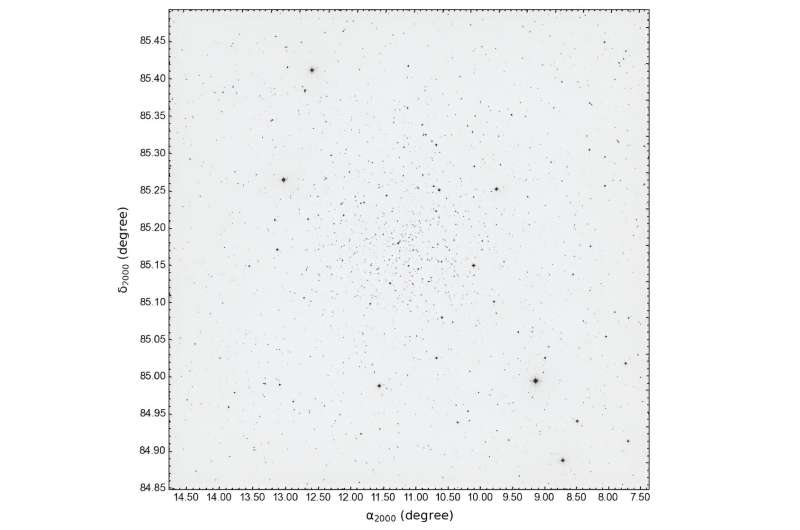
Identification chart of NGC 188 for region 40 40. The up and left directions represent north and east, respectively. Credit: Dursun et al., 2024.
Using data from ESA’s Gaia satellite, astronomers from Turkey and India have investigated NGC 188, an ancient open cluster in the Milky Way. The results of the study, published on April 19 on the preprint server archivprovides important information about the parameters and properties of this cluster.
Open clusters (OCs), formed from the same giant molecular cloud, are groups of stars bound together by gravity. So far, more than 1,000 of them have been discovered in the Milky Way, and scientists are still looking for more, hoping to find a variety of these star clusters. Expanding the list of known galactic open clusters and studying them in detail could be crucial to improving our understanding of the formation and evolution of our galaxy.
NGC 188 (also known as Melotte 2 or MWSC 0074) is a galactic OC estimated to be several billion years old. Since the cluster is located in a relatively low-contamination region of the Milky Way, it is an excellent object for detailed observations.
However, many parameters of NGC 188 still remain uncertain, as previous studies point to different results. That is why a team of astronomers led by Deniz Cennet Dursun of the University of Istanbul in Turkey, decided to take a closer look at this OC. They analyzed photometric, astrometric and spectroscopic data from Gaia Data Release 3 (DR3) to resolve discrepancies in archival datasets.
“This paper aims to determine the fundamental parameters that define the ancient open cluster NGC 188 using advanced analytical techniques such as isochronous fitting and SED. [spectral energy distribution] analyses,” the researchers wrote.
First, Dursun’s team identified 868 most likely member stars of NGC 188 (within the limiting radius of 15 arcmin) of which 19 turned out to be delayed blue stars (BSS). From this sample, they determined the properties of the cluster.
The study found that NGC 188 is a member of the thin disk component of the Milky Way and orbits in a square pattern outside the solar circle, with an orbital period of about 259 million years. The data indicate that the cluster’s formation region is outside the solar circle.
According to the paper, NGC 188 is about 7.7 billion years old and has a metallicity of -0.03 dex. The distance to the cluster was estimated at approximately 6,000 light years.
The study also found that the determined effective temperatures and surface gravities of the NGC 188 members align well with predictions based on stellar evolution models at different luminosity classes.
According to the authors of the paper, their study shows that with the increase in the number of photometric data, the fundamental astrophysical parameters of COs can be determined more precisely.
More information:
Deniz Cennet Dursun et al, SED Analysis of the Old Open Cluster NGC 188, archiv (2024). DOI: 10.48550/arxiv.2404.13115
Magazine information:
archiv
2024 Science X Network
Subpoena: Researchers explore an ancient open galactic cluster (2024, April 30) Retrieved May 1, 2024, from https://phys.org/news/2024-04-explore-galactic-cluster.html
This document is subject to copyright. Other than any fair dealing for the purposes of private study or research, no part may be reproduced without written permission. Content is provided for informational purposes only.
#Researchers #explore #ancient #open #galaxy #cluster
Image Source : phys.org